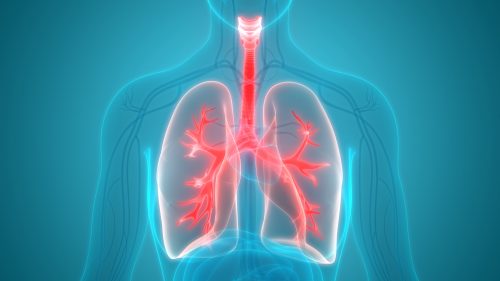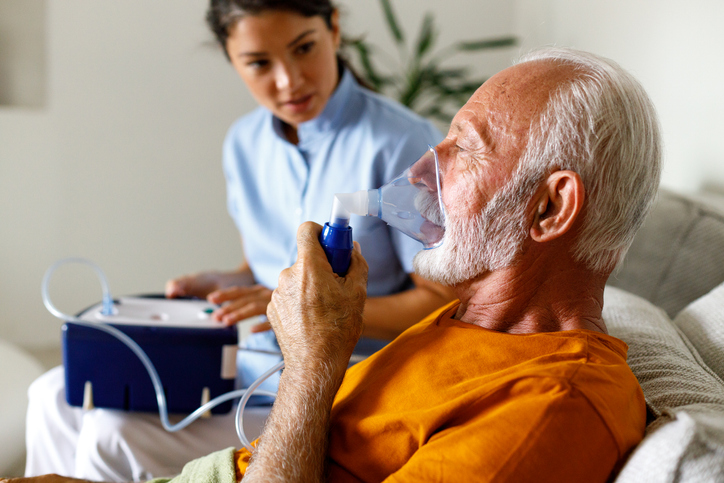
The National Institute for Health and Care Excellence (NICE) has shared new guidelines pertaining to the diagnosis and management of chronic obstructive pulmonary disease (COPD).
New recommendations were made on topics including “incidental findings on chest X‑rays or CT scans, prognosis, inhaled therapies, prophylactic antibiotics, oxygen therapies, managing pulmonary hypertension and cor pulmonale, lung volume reduction procedures, and self-management and exacerbation plans.”
NICE has today published new antimicrobial prescribing guidance for #COPD, and updated its broader COPD guideline. Find out more here: https://t.co/5ECNGWtU1i #AntibioticAwareness pic.twitter.com/YnuOHfKvXJ
— NICE (@NICEComms) December 5, 2018
Regarding diagnosis, NICE now recommends that people with emphysema or possible chronic airways disease as indicated by a chest X-ray or CT scan be considered for primary care respiratory review and spirometry. Also new for 2018 is an emphasis that even without symptoms, “emphysema on a CT scan is an independent risk factor for lung cancer.”
Latest NICE guidance on COPD management presented @ BTS winter meeting pic.twitter.com/CTkEvIfK9N
— Pradeep Kumar Mallisetty (@PMallisetty) December 6, 2018
NICE now advises against using a multidimensional index to evaluate prognosis for stable COPD patients.
Lung volume reduction (LVR) in the new 2018 COPD guideline update from @NICEcomms https://t.co/20Qy0Zc5DE @BTSrespiratory @respfutures Thread 1/9 pic.twitter.com/2nbLdUvhIq
— Dr Nick Hopkinson (@COPDdoc) December 11, 2018
Patients using a short-acting bronchodilator who still experience breathlessness or exacerbations are now recommended for combination long-acting muscarinic antagonists (LAMA) and long-acting beta2 agonists (LABA) treatment, and combination LABA and inhaled corticosteroids (ICS) treatment.
Our new guidance says healthcare professionals should develop an individualised self-management plan in with each person with Chronic obstructive pulmonary disease #COPD and their family members or carers: https://t.co/D1BABfSCau#lunghealth #lung #BreatheEasy #MondayMotivation pic.twitter.com/9K8mPK3nPt
— Get Involved at NICE (@NICEGetInvolved) December 10, 2018
NICE recommends reducing how many inhalers and types of inhalers each person uses as much as possible, and, “When prescribing long-acting drugs, ensure people receive inhalers they have been trained to use (for example, by specifying the brand and inhaler in prescriptions),” according to the guidelines.
Chronic obstructive pulmonary disease in over 16s: diagnosis and management | Guidance and guidelines | NICE #bts #copd https://t.co/vUxnF67tvU
— GeeshJayasekera (@Geeshath) December 12, 2018
Also new for 2018 is consideration for prophylactic antibiotic therapy—NICE recommends considering input from a respiratory specialist prior to therapy initiation. Prior to initiation, patients should also undergo a thorax CT scan to eliminate the possibility of bronchiectasis or other lung pathologies.
New NICE COPD Guideline out today. Great to see pulmonary rehab recommended as an early treatment option @LiH_COPD @jerri88 @BarehamDave @ https://t.co/CwAd9BBDj9
— LCHS Respiratory (@LchsRespiratory) December 5, 2018
Several updates were also made pertaining to azithromycin. Before starting treatment with azithromycin, patients should undergo baseline liver tests. Patients should also be informed about potential hearing loss and tinnitus as side effects and be instructed to contact a healthcare professional if they experience this. Follow-up should be conducted three months after initiation, and then every six months going forward.
Prophylactic antibiotic treatment should only go on “if the continued benefits outweigh the risks,” as no long-term studies on their use in COPD patients have been conducted, according to the guidelines.
“For people who are taking prophylactic azithromycin and are still at risk of exacerbations, provide a non-macrolide antibiotic to keep at home as part of their exacerbation action plan,” the recommendations add.
Numerous updates were made to recommendations pertaining to oxygen, including not giving short-burst oxygen therapy to COPD patients with mild or no hypoxaemia at rest who are experiencing breathlessness. These same patients should also not be given ambulatory oxygen. Ambulatory oxygen should be considered for COPD patients with exercise desaturation whose exercise capacity improves with oxygen and who “have the motivation to use oxygen,” the guidelines recommend.
To read the full recommendations, click here.
Asthma-COPD Overlap: What Is Known and What Is Not
The Allergist’s Guide to the GOLD Guidelines for COPD
Increased mortality among patients with rheumatoid arthritis and COPD: A population-based study
Obesity in COPD: Comorbidities with Practical Consequences?
Source: NICE







 © 2025 Mashup Media, LLC, a Formedics Property. All Rights Reserved.
© 2025 Mashup Media, LLC, a Formedics Property. All Rights Reserved.